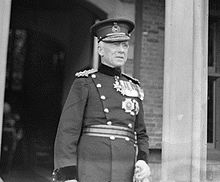John Talbot Hobbs
Sir Joseph John Talbot Hobbs KCB , VD, KCMG (born August 24, 1864 London , † April 21, 1938 at sea) was an Australian general of British descent, architect and division leader in the First World War .
Life
Early time
Joseph John Talbot Hobbs was the son of the carpenter Joseph Hobbs and Frances Ann Wilson. He attended the Merton School of St. Mary Church in Surrey and then worked as an architectural draftsman for the building contractor John Hurst, with whom he moved to Perth , Australia in 1887 . There he initially worked as a carpenter, but soon founded an architecture office. Talbot Hobbs architecture firm soon became a leader in Perth.
On April 24, 1890, he married Hurst's daughter, Miss Edith Ann (November 20, 1865 - July 23, 1943) at St. George Cathedral and had three sons and four daughters. A victory in the competition for the design of the World Club in 1891 was followed by a number of other contracts for public and private buildings in Perth and Fremantle . In 1896 he became the first director of the newly founded West Australian Institute of Architects, of which he was president from 1909 to 1911. In 1905 he founded Hobbs, Smith & Forbes as a senior partner. His frail-looking, small stature deceived the persistent energy and activity that determined his entire life. In his private life he was an avid sportsman and practiced fencing, rowing, sailing and boxing. As a devout Christian, he worked for the Anglican Church's diocese of Perth as an architect and economic advisor.
Military career
In 1883 he joined the Perth Field Artillery Volunteer Regiment. In 1903 he was given command of the first (Western Australian) field battery and in 1908 was appointed Lieutenant Colonel in the Western Australian Brigade. In 1913 he rose to colonel and was given command of the 22nd Infantry Brigade. Hobb's military training brought him four times (1897, 1902, 1906 and 1913) to England, where he financed advanced artillery courses, often at his own expense.
With the outbreak of the First World War in August 1914 Hobbs was appointed divisional artillery commander of the Australian 1st Division by General Bridges . In 1914 his unit was embarked for Egypt and in 1915 brought to the new theater of war in Gallipoli as part of the ANZAC . For a short time from October to November 1915 Hobbs represented the wounded Brigadier General Walker as commander of the 1st Division. Hobbs, suffering from dysentery, had to leave Gallipoli in November 1915 . After his recovery he was used again as the artillery commander of the 1st Division, which was returned to Egypt. Hobbs was in command of sixteen batteries . In March 1916 the large formation was relocated to the Western Front and Hobbs proved his worth by coordinating his artillery use during the Battle of the Somme in the July 1916 attacks at Pozieres and at Mouquet Farm.
New Year's Day 1917 brought Hobbs promotion to major general and command of the Australian 5th Division , with which he was subordinate to General Elliott . His debut as division commander took place on the south wing of the Battle of Arras , a poorly managed attack by his division on Bullecourt failed. His division achieved more success in the Third Battle of Flanders , in September 1917 the conquest of the Polygon Forest succeeded. In April 1918 the 5th Division successfully participated in the defense against German attacks on Villers-Bretonneux . In the Hundred Days Offensive , his troops took part in the Battle of Amiens from August 8th . On September 2, his troops succeeded in occupying Peronne and then breaking through the Hindenburg Line at Bellicourt . On November 28, 1918 he was promoted to Lieutenant General and at the beginning of 1919 received the KCMG from King George V.
post war period
After his return home and in his previous job, the government commissioned him to design war memorials. Hobbs designed the West Australian War Memorial in Perth. Of the six Australian memorials on the Western Front, five, including the one at Polygon, were based on Hobb's designs. In April 1938 Hobbs embarked with his wife and daughter for the unveiling of the Australian war memorial in Villers-Bretonneux for France. He suffered a heart attack while crossing at sea and died on April 21. His body was returned to Perth via Colombo. The burial with state and military honors took place on May 14th after a service in St. George's Cathedral in Perth. He left an estate valued at an estimated £ 31,000 and a memorial in his honor was unveiled on Perth Esplanade in 1940 .
literature
- AJ Hill: Hobbs, John Talbot . In: Douglas Pike (Ed.): Australian Dictionary of Biography . Volume 9. Melbourne University Press, Carlton (Victoria) 1983, ISBN 0-522-84273-9 (English).
| personal data | |
|---|---|
| SURNAME | Hobbs, John Talbot |
| ALTERNATIVE NAMES | Hobbs, Joseph John Talbot |
| BRIEF DESCRIPTION | Australian artillery officer and division commander |
| DATE OF BIRTH | August 24, 1864 |
| PLACE OF BIRTH | London |
| DATE OF DEATH | April 21, 1938 |
| Place of death | at sea |
